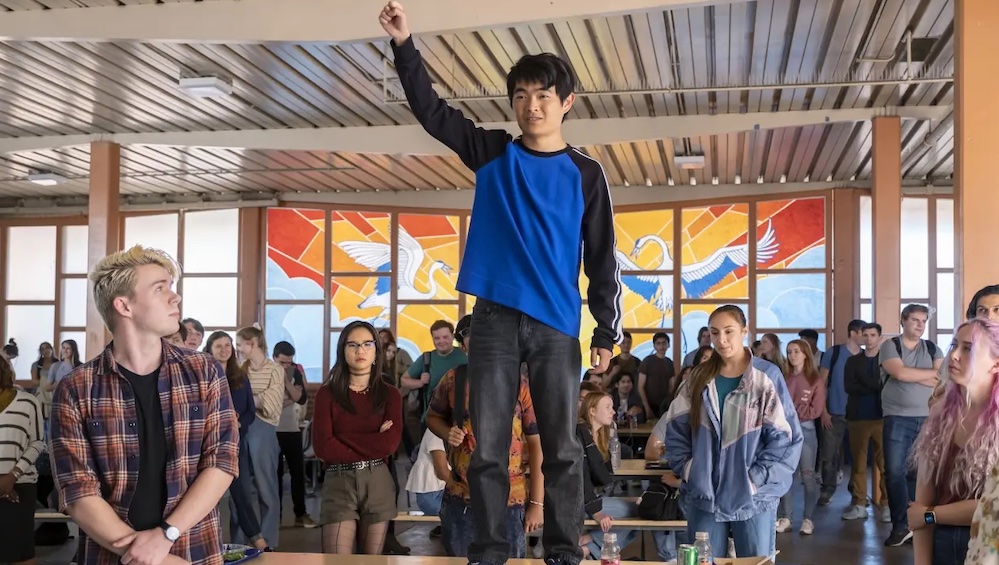
Michele Yu and Cindy Chao come as a package deal. Friends and work partners, they’ve served as Production Designers on numerous movies and television shows, and count among their credits The Fuzees, Much Ado About Nothing, Grandma, and A Black Lady Sketch Show (for which they earned an Emmy nomination). Their latest project is the new Disney+ series American Born Chinese, or ABC for short.
ABC is a real game-changer for the duo. It’s by far their highest-profile gig yet, and it should not be lost on anyone that there’s something special about two Asian American women working on a show featuring Asian Americans both in front of and behind the camera. Their stellar work on ABC helps bring the pages of Gene Luen Yang’s graphic novel to vivid life, meaning scenes set in the present, in the 1970s, and in a fantasy version of heaven.
Below the Line recently caught up with Yu and Chao via Zoom for an extensive conversation. They discussed how they met and became a tandem, the challenges and pleasures of working on American Born Chinese, the importance of the show’s AAPI inclusivity, and their frustration with the Alliance of Motion Picture and Television Producers (AMPTP).
[Note: This interview has been edited for clarity and length]
Below the Line: How did you two meet?
Michele Yu: You’d think we’d have a scripted answer by now, but we do not. We met in college. We both went to UC San Diego for undergrad, as not necessarily film and TV related majors. We actually met working on the same student publication. I was a photographer because it got me into concerts for free to take photos, and Cindy was a writer. What did you write, concert and CD reviews?
Cindy Chao: I interviewed bands and I wrote about them.
MY: There was a world where we could have ended up on your side of the Zoom, but instead what happened was after we both graduated — we’re both from L.A. and had a lot of friends who went to film school after undergrad; we did not — we both got jobs in the industry, working in offices and sitting in front of computers at desks. Our friends were in film school learning how to be Directors, Producers, and DPs, but the one thing that was missing from the equation in their programs was nobody had a production design program. We ran back into each other — Cindy and I — working on mutual friends’ sets. We were often the only art department folks in the mix, project to project, and that’s how we began our partnership.
BTL: How quickly did you find yourselves in sync when it came to designing things?
CC: Almost immediately. Both Michele and I have the same taste. That’s how we bonded, too. Michele studied fine arts and is talented with drawings and paintings. I was just in awe of her skills. With design, we gravitated towards the same artists and styles of furnishings. Even when we’re doing research, we’re pulling almost the same boards.
We had differences, but it’s nice to work with someone who can finish your sentences sometimes, knows exactly what you’re thinking, and can actually empathize on a friendship level. If you’re going through something and something at work doesn’t feel right, it’s nice to have a partner who is feeling the same exact things. Design-wise, it’s the perfect collaboration. That’s why we’ve been doing this together for over 20 years now.
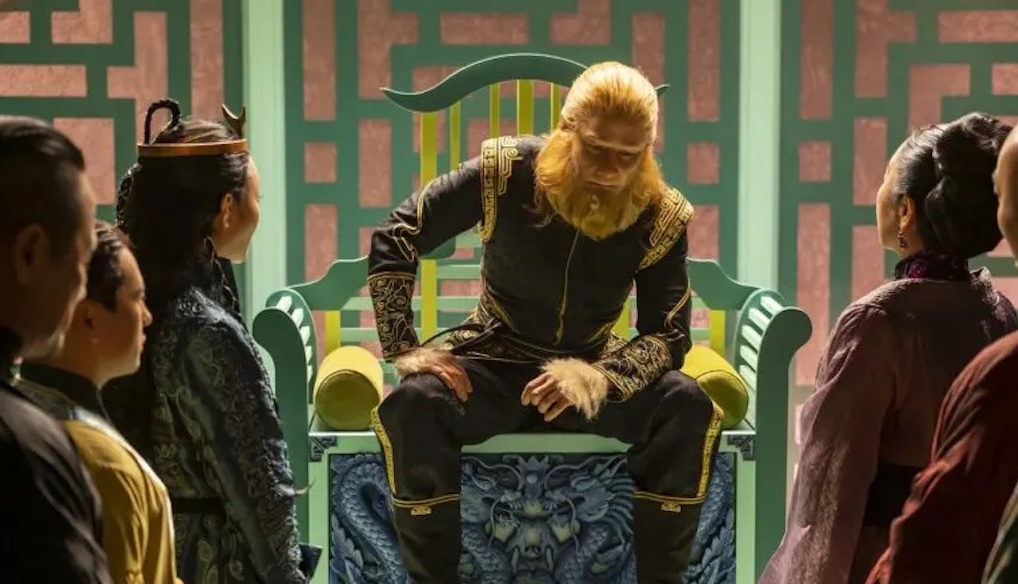
BTL: You two — especially 15 or 20 years ago — were complete unicorns: a production design team, two women, and Asian American females. How has Hollywood, and how has your world within Hollywood, changed from 20 years ago to now?
MY: Something like ABC, which we are so proud of, was not even an option for a project to book back then. I will say, back then, some of our friends in film school, their projects that they were doing were about their identities and these nascent ideas of how to represent our culture in media. That was a little bit of our training ground. We did a short with our friend Cindy Fang on Manzanar. We did other things about K-Pop idols. The culture has always been there, but the availability of a wide medium with which to express that culture has not always been there. That’s what’s changed. People have always been writing and producing projects about their experiences, but something like ABC was not going to get greenlit 15 years ago.
CC: In the beginning, Michele and I, we did a lot of indie rom-coms. We love that genre, but after a while it’s like, “How many of those can we do?” Like Michele said, we would gravitate towards doing shorts that highlighted our personal stories or interests and that satisfied our hunger, doing those small projects. When it came down to getting an opportunity to interview for American Born Chinese, both of us thought that if we didn’t get this our careers would end.
MY: We would quit. We would walk away and be like, “Well, if we can’t do that, why would we do anything else?”
CC: We had been preparing for a story like that because that story is truly about — not us — but our friends and families. There are a couple bigger shows that we’d be heartbroken if we never got the opportunity to work on them. Being able to interview for American Born Chinese was such a great opportunity that when we got it, we were so thrilled to have the opportunity to share our personal experiences with the world.
MY: It’s also the difference of how the landscape has changed. The story of American Born Chinese was written and published in 2006, and you can track how the landscape has changed based on the path of this one story. In 2006, the path available for Gene Luen Yang’s story to be distributed was a niche graphic novel, for a very specific market. Seventeen years later, it’s now a big, splashy TV show on Disney+, one of the primary, predominant streaming platforms in the Western world right now. Just that, it’s the full picture.
BTL: How familiar were you with the graphic novel?
CC: To be honest, I was not familiar with it at all. I had heard about it and knew it existed, but I actually never read it. I don’t know why. That graphic novel should be in schools. When we were getting ready to interview for it, I immediately got the book and read it that same day. I was shocked that I hadn’t picked it up back in college. I’m glad it’s now being exposed to the world because it’s such a real story. Gene did such a great job detailing the experience of what it’s like, linking it to a very famous, historical and mythological story about the Monkey King that I was familiar with, but also didn’t know too much about it other than the fact that my parents would watch it. It was very famous in Chinese and Hong Kong media. Being on this project exposed me to a lot of my Chinese heritage that I’d shoved under the bed, because that is part of being a Chinese American.
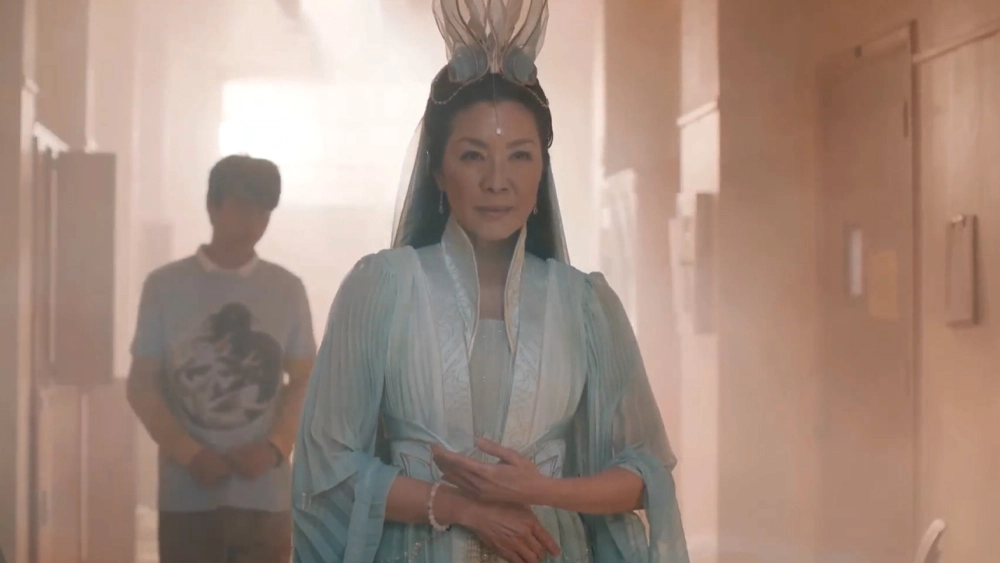
BTL: What would you say the mission statement given to you on this was?
MY: Make something real, make something grounded, throw in some Kung Fu to make it spectacular as well. We wanted this job and, and we were hired because of the very genuine conversations that we were able to have with Gene, Destin Cretton, and Kelvin Yu creatively early on about this being a show that had a mission of representing a grounded and genuine look at what it is like to grow up as an Asian American teenager or as an Asian American person right now, specifically in southern California. That helped, because both Cindy and I grew up here in about the same timeframe as Gene’s original characters in the graphic novel.
It was maybe the most intimidating mission of all, which is to represent something on screen that hasn’t been seen before but that all of us lived. It had to hit every note of authenticity, which is a loaded word when you’re talking about the Asian American experience. We had to create a show where an Asian American person could watch it and feel connected immediately to how real it felt, to recognize themselves in the sets, recognize their families in the Wang House, and see part of their experience on screen that hadn’t been seen before.
BTL: What design elements, particularly on the fantasy side of the equation, would you say were the biggest challenges for you?
CC: The biggest challenge I would say is making the depiction as authentic as possible, but also making it different. The story of the Monkey King is such a famous story and it has been depicted in several media in China. This is the first time it’s actually been exposed in America. We wanted to do our own depiction of it, but also relate and not do a disservice of what is known about that story. Our whole thing was, “What would a contemporary Chinese heaven look like?” but not try not to do the same thing that’s already been done.
Gene did such a great job with his graphic novel and the color palette, so we wanted to stick close to that as well; streamline the motifs and the architectural details that we’ve seen in China’s architecture. Streamline it so that it’s still recognizable, but our own. We went in there inspired by a lot of drawings of clouds and moon gates. We took those images and integrated them into our own version. We used some of the colors that Gene used in the graphic novel and tweaked them so that it was reflected in our version.
BTL: Much of your work has been of the independent film variety and a lot of TV shows. What was it like to work on something so much bigger and massive in scope?
MY: There is an awareness when you book a job like this that it’s going to get seen and be on a big platform, but when you’re doing the work, you’re not thinking about that.
BTL: It’s still the same?
MY: Yeah! That’ll stall you, and you can’t think about that too much. There is so much to do. You’re starting up a project and it’s the first season. Even if it’s not the first season, there’s so much work to do. There’s so much stuff to figure out creatively and logistically. There’s no time to get freaked out about who’s going to see it a year or two down the line. So, we’re not thinking about that.
What we’re thinking about is the immediate part of it, “Okay, we’ve got to find these locations. We’ve got to figure out these textures, colors, this palette, the materials, design the set, and how to communicate it with everybody.” We were just jumping in and creating a show. When looking at the bigger picture now, that’s something we are doing after the fact, like, “Oh, it’s coming out. It’s coming out tomorrow!”
CC: When we landed this show, I always knew that it was going to be a big thing because — for ourselves — it was such a big deal. I always felt like this was going to be so exciting, to do something like this. I don’t think we realized how stunt-heavy this show was going to be. We weren’t expecting every episode to have a big stunt sequence.
MY: When you’re reading the script, it just says, “They fight.” It doesn’t have the details of the guy jumping 20 feet in the air and twirling.
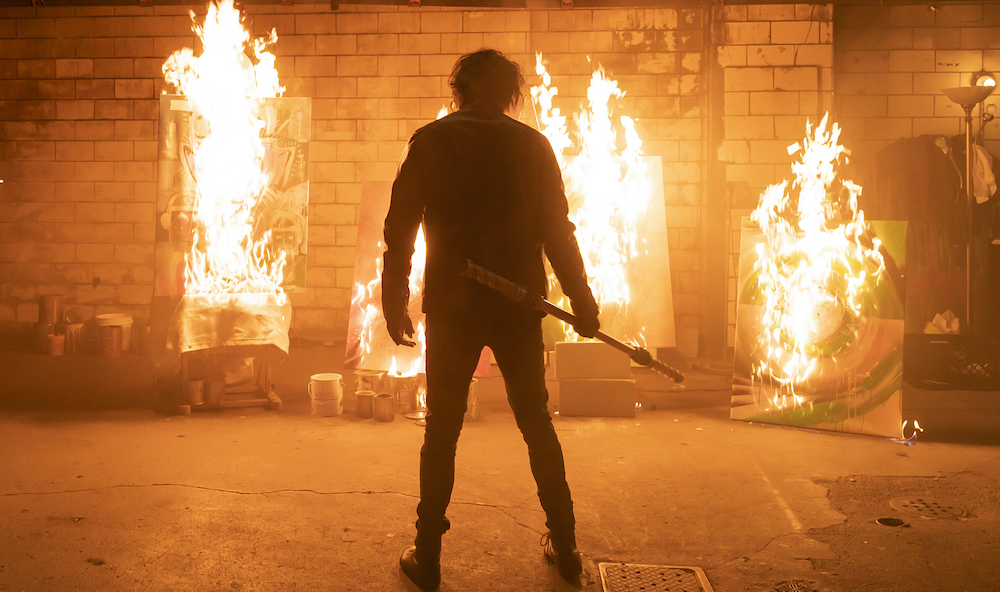
BTL: You need room for wires, plus they’re going to blow up your sets. You’ve got to get a stunt crew, lighting, and wires. All of it.
CC: I remember when the Stunt Coordinator came onto the show, Liang Yang. He is such a great person and collaborator, but he always had these previews of all his stunt sequences. The first one that he showed us — which is that first sequence in Episode 1 — it was so exciting to watch. He had filled in all the visual effects himself. It was just a model. All the walls and things that they were going to be hitting were just cardboard boxes, but it was already planned out and calculated.
The fact that we were able to see a preview of it was truly exciting, because the involvement that we had to be a part of was the biggest scale Michele and I had ever done. Like Michele was saying, you don’t have time to worry or freak out. You have to figure out how to get it done, and then you get steamrolled into the next one. You just keep doing it. It’s not until you see the rough edit or when they’re actually shooting it and you see the dailies that it’s like, “Wow. That was fucking pretty awesome. We did that as a team!”
MY: The visual effects, too. It was so important. We had a little bit of time to get to know her before things got too crazy, but we worked with Kaitlyn Yang – our Visual Effects Supervisor. More and more, on every show, whether you’re a giant fantasy stunt show or not, visual effects are so important nowadays. You start that relationship early, as early as production will allow, whenever they hire that VFX supervisor in the prep process. But Kaitlyn was on early, so we got to know her. We got to form a rapport with her. We talked to her almost every day and kept in communication about her needs because we didn’t know what her needs were, not having worked on a giant VFX spectacular before. The easiest way to do it was to ask questions and be open about what you know or don’t know; not have any ego around it. People are more than happy to lend their expertise and inform the conversation, you just have to be open to having those conversations.
At the end of the day, I know it was a big stunt show and it had huge VFX, but I feel like our approach to the design didn’t change much from early on. It all starts with the characters. We immediately dove into who they were in the details of their lives and all of that informed the rest, honestly. All the rest — the stunts and things that we hadn’t done before — those were conversations that we were happy to enter into with other folks who were happy to guide us.
CC: It is Gene’s story about his struggle with identity and being able to design that house — even the sitcom show, and we haven’t talked yet about the production design of the sitcom show — that was a story in itself. That was an opportunity for us to showcase how shows back in the day would stereotypically design for a character that was not white. It was uncomfortable to place generic artwork and rice screens in there. They would do that back then, and it would be offensive for us to watch it. You have that contrasted to something that’s authentic in the long haul. Then you have something that’s fantastical with Chinese heaven, and you basically designed all three levels of what it means to be a Chinese American.
BTL: There’s no deep way to ask this, but how cool was it to have the mighty Michelle Yeoh walking through your sets and kicking ass?
MY: We were just in a corner beside ourselves every time we spotted her from afar.
CC: Not that many designers can say they designed Michelle Yeoh’s San Gabriel apartment
MY: Yeah, the goddess’s apartment. We held her at such a distance because she is such an icon, but it does her a disservice because as a human being she’s very approachable, loving, warm and all of the wonderful things. I am not gonna lie; she has an aura about her.
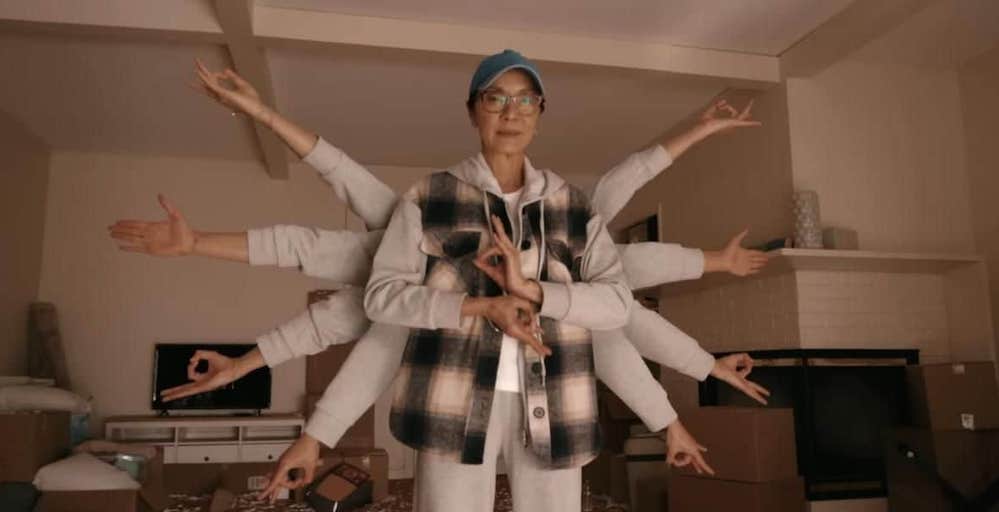
BTL: The show — from top to bottom, from the cast to the crew to creatives — is so AAPI inclusive. Going back to one of my first questions, you’re now not quite the unicorns that you used to be. How satisfying is that?
MY: It’s amazing.
CC: It’s an honor to even be a part of such a revered cast and crew. Everyone is so talented. They put their heart, sweat, and passion into this and it really shows. It was also a very inviting experience. Michele and I, obviously we gravitated towards each other because we’re Asian females interested in the arts. I know there’s a lot of us out there, but when you’re able to work with your peers, it’s such a connecting experience. It’s not like that every day in this industry. We’re usually the ones that are the outsiders, the ones in the shadows. It never felt that way on this set. With the caliber of everyone and to be part of it, it is such an honor. I’m so grateful to this day.
MY: I’m just happy to have so much competition for jobs. (Laughs) In all seriousness, though, we were lucky enough to book this one, but there are Asian American Production Designers, Cinematographers, and creatives all across the board right now working below the line. They are visible in a way that they never have been before. There are certain jobs we want and when we hear that we’ve lost out to our peers, like Yong Ok Lee, Grace Yoon, or somebody else, we’re like, “Good for them! Somebody else booked this, and there’s more than just us out here as options.”
One of the strengths of our partnership is that we are two perspectives focusing on the same story together, so that just enriches it, but we’re not the end all, be all of Asian American storytelling. It’s great to know that there are peers out there now, Asian Americans in production design and art departments, specifically, so that we can all tell our individual stories. All of our stories are so different. It’s exciting.
We started our careers at a time when there were no Asian American production design mentors to look up to or contact. We never worked with a mentor, but at this point Cindy and I often talk about, “Should we hit up Sue Chan and see if she wants to have a conversation?” There are contemporary folks who are working today, and we look up to them. We look up to their work and see them as potential mentors. It’s exciting to know that we might be in the same spaces as them and be able to have these conversations now, because we actually know who they are now.
BTL: What’s next – or is the strike everything out of whack?
MY: We have been working on a show all this first half of the year that we can’t say much about, but the AMPTP’s unwillingness to go back to the table has stalled the industry. I’m not going to say that the strike did it, because the strike is a result of the AMPTP’s decisions. That has gotten in the way of us completing the show that we’re currently on, but now we’re going to get a summer vacation and we’re going to get back to it once the producers come to their senses.
American Born Chinese is streaming now on Disney+.





